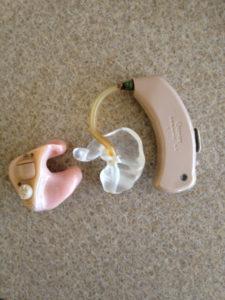- The Impact of Hearing Aids on Veterans’ Lives - February 15, 2024
- Hearing Health: A New Year’s Resolution for a Vibrant Life - January 16, 2024
- Unraveling Misconceptions About Hearing Loss - December 12, 2023
One day, a lady came into my office with her husband while he had his hearing tested. Upon completion of the test, we discussed hearing aid technology and styles. She was very skeptical about hearing aids due to her recollection of her father’s experience with hearing aids. She remembered that they were very large and whistled all the time and when he wore them and he was forever adjusting the aids. He could not stand them in back ground noise and often left the hearing aids in the drawer. Her father’s hearing aids definitely left a bad impression on her. Fortunately, her husband was not swayed by all her negative comments and is a very happy hearing aid user, enjoying the sounds of life once again.

Billions of dollars are spent every year on research by the hearing aid manufacturers. Research scientists comprised of audiologists, physicians, electrical and sound engineers, and others work together to bring you the best hearing possible in the smallest space possible. They study, how the ear works to gather the sound, and the path it takes to bring the signals to the brain for interpretation of that sound. The brain is studied to find out how it processes sound once it is heard. The more they learn, the better able they are to mimic what a normal functioning hearing system does through the use of highly sophisticated miniaturized computers that are found in today’s digital hearing instruments. As electronic components get smaller so do the hearing aids.
Today very sophisticated feedback reduction systems prevent the annoying whistling hearing aids once produced. When fit properly, some never whistle. Miniaturization of components allow for nearly invisible hearing aids. These two improvements allow for stronger hearing aids in smaller packages with larger air flow venting for a more comfortable fit without feedback.
Grandpa’s hearing aids were amplifiers that increased the volume of everything. Today, hearing aids have sophisticated noise reduction systems. In the best technology available, both the omni and directional microphones are now adapting in such a way that they can detect speech from the front, back, and right and left, automatically. Studies have shown that the new Signia Primax hearing aids reduce listening effort throughout the day while providing “better than normal” hearing in challenging listening environments as busy restaurants and cocktail settings. In addition, wireless technology allows hearing aids to connect to other media devices and cell phones. The list goes on!
With today’s technology listening effort is reduced, helping reduce sensory overload. It has also been found that people who wear hearing aids are less likely to have cognitive issues compared to those with unaided hearing loss.
If you have been struggling with hearing loss, it is the time to take care of it. Have your hearing tested by your local Hearing Care Provider today, and hear what you have been missing!
